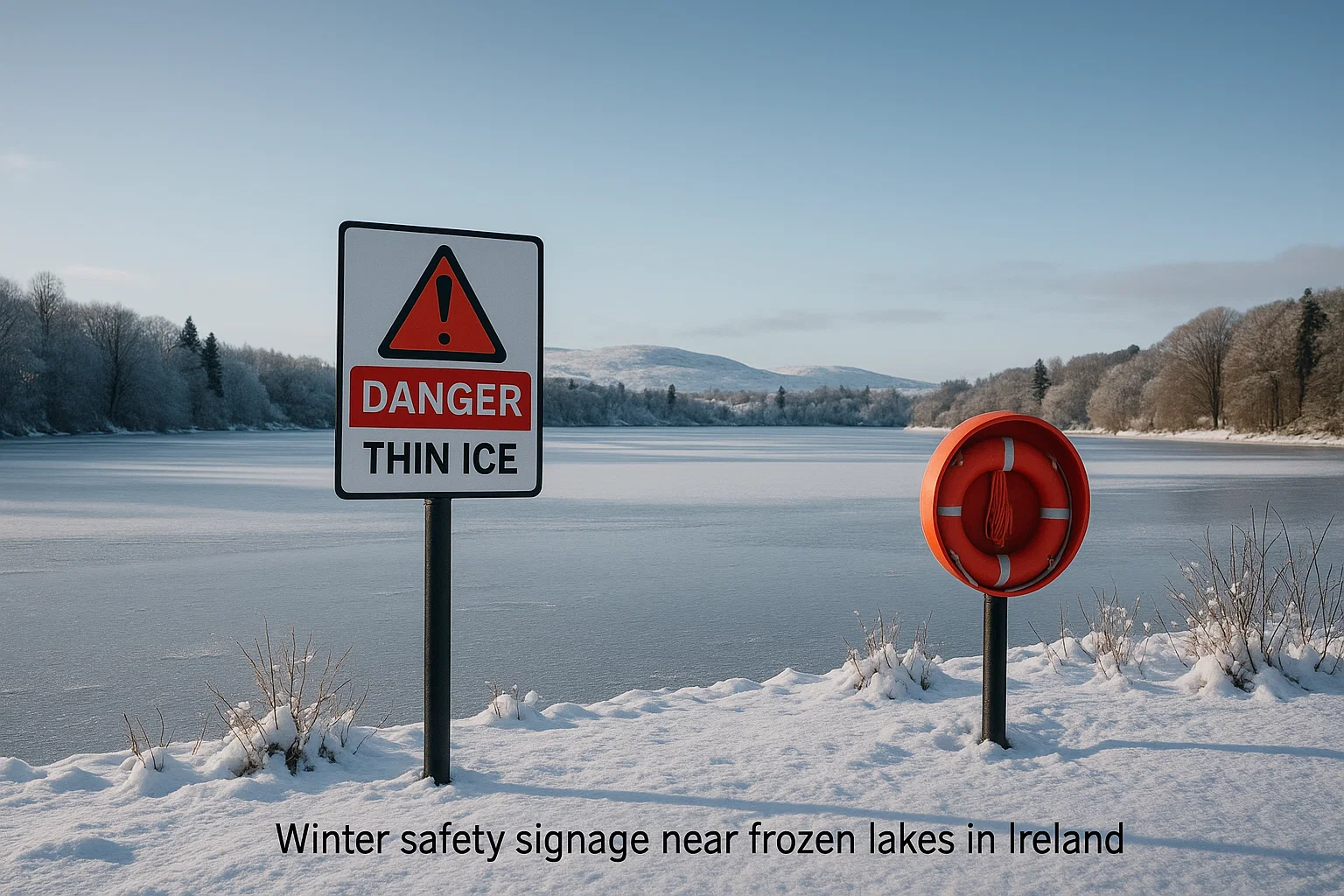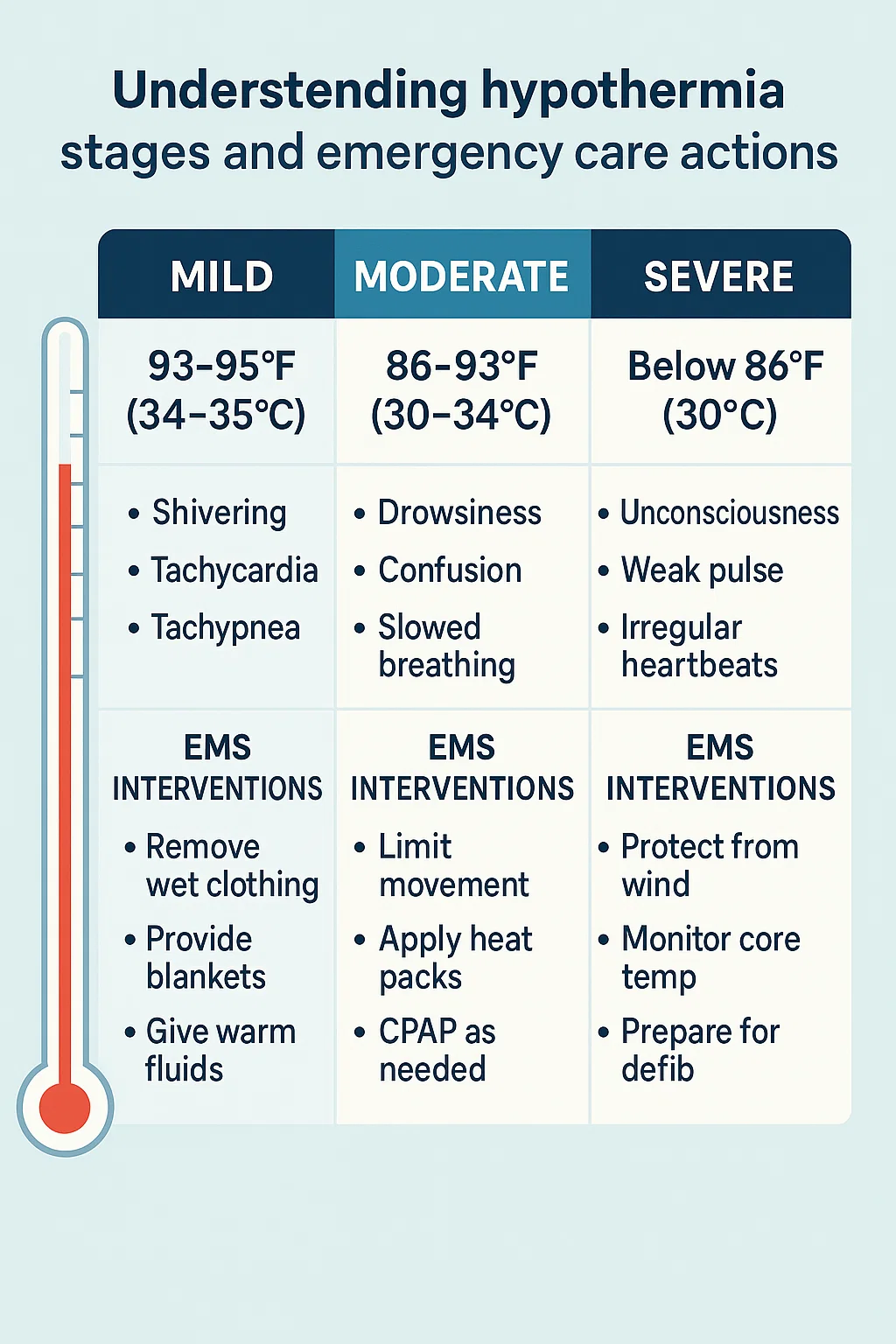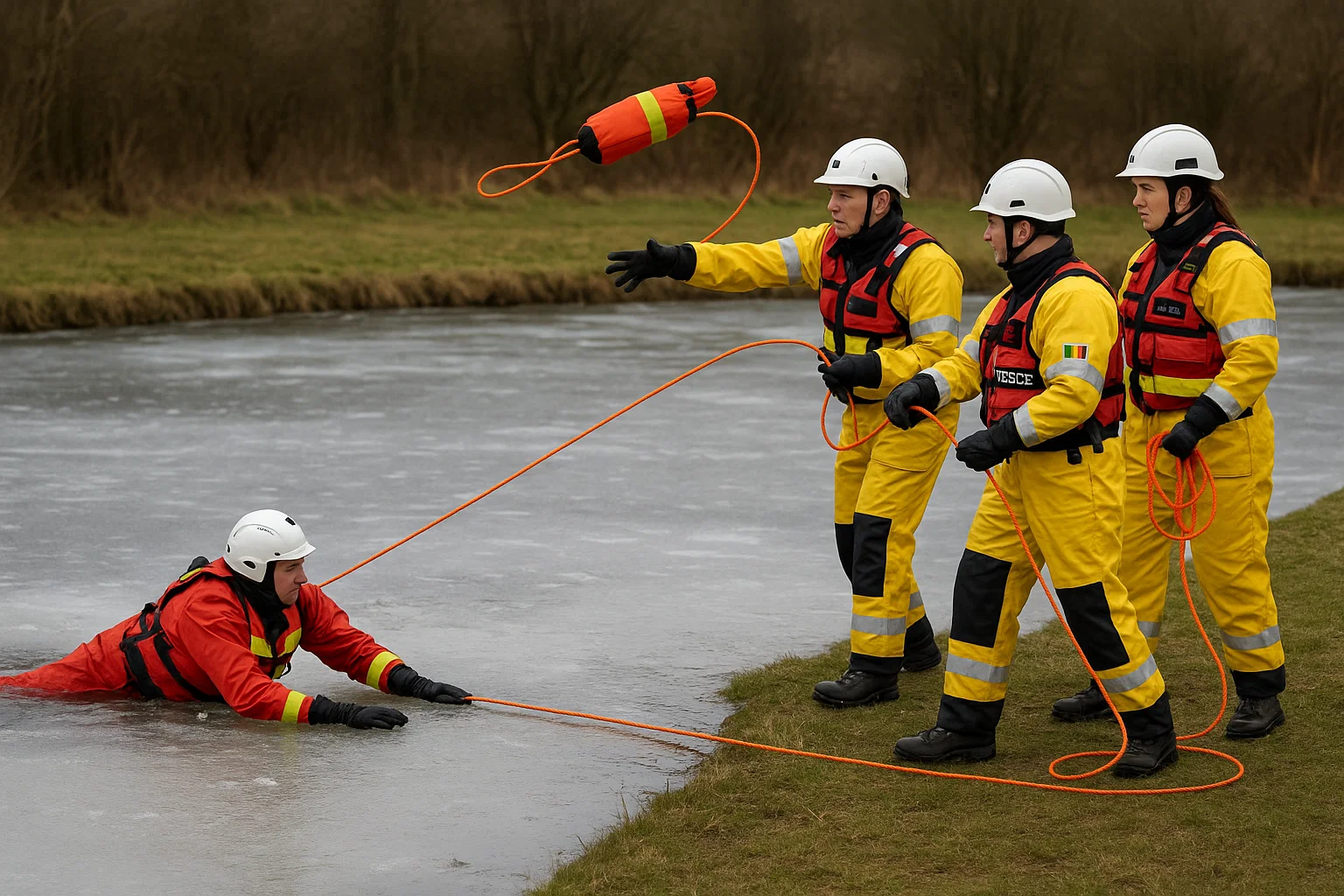
Understanding how to stay safe, perform an ice rescue, and prevent hypothermia is not just good practice it’s lifesaving knowledge.
This comprehensive guide brings together Ireland’s latest winter-safety standards, real-world rescue procedures, and medically accurate hypothermia care explained by field responders for everyone.
Understanding Ice Rescue & Hypothermia in Irish Conditions
Ireland’s winters rarely deliver the prolonged deep freeze seen in continental Europe, yet short cold snaps can rapidly form thin layers of ice on still water. These deceptively solid surfaces lure unsuspecting children, anglers, and pet owners.
Irish Water Safety (IWS) and the Health and Safety Authority (HSA) warn that no natural ice in Ireland should ever be presumed safe. Even a few days of frost cannot sustain body weight across rivers, ponds, or reservoirs.
For professional rescuers and community responders, the Public Health Emergency Council (PHECC) Clinical Practice Guidelines (CPGs) provide structured care for hypothermia management, while operational tactics are informed by NFPA 1670 Cold-Water Rescue Level and OSHA Cold-Stress Guidelines.
These frameworks are echoed across Irish Coast Guard and Civil Defence operations.

Key Environmental Facts
- Air temperature below 5 °C combined with strong wind produces severe wind-chill effects.
- Water temperature under 15 °C triggers involuntary gasping the start of Cold Water Shock.
- Average Irish inland water temperature in January: 3–6 °C enough to cause loss of muscle control in under five minutes.
Common Causes of Ice Emergencies and Hypothermia
Many rescues begin with simple human error. People chase dogs, test ice thickness, or attempt a shortcut across frozen ground.
Hypothermia can strike quickly even without full immersion when clothing becomes wet and wind removes body heat faster than it can be generated.
Typical Triggers
- Pet or person falls through thin ice.
- Vehicle or bicycle enters flooded, frozen roads.
- Unsupervised children playing near canals or reservoirs.
- Anglers breaking ice at edges and slipping in.
Cold Water Shock Explained
The RNLI’s 2024 campaign highlighted that cold water shock is an immediate physiological response a gasp followed by hyperventilation, rapid heartbeat, and loss of coordination. Survival depends on resisting the urge to swim.
Victims must float, control breathing, and signal for help until rescue.
Pro Tip: Never walk onto ice to test its thickness. In Ireland, no ice is guaranteed safe even if it held someone moments earlier.
Emergency Response Procedures Step-by-Step
Every ice rescue follows one golden rule: protect rescuers first.
Unplanned entry often turns one casualty into several. The following sequence aligns with ICS Ireland and NFPA-compliant cold-rescue protocols.
1. Scene Size-Up & Command
- Assess from shore. Identify hazards weak ice, current, wind, and access points.
- Establish Incident Command (IC). Assign roles: Rescue Lead, Medic, Safety Officer, Communications.
- Create a safe zone. Keep bystanders away; mark the ice perimeter.
- Call emergency services (112 or 999) immediately, providing clear location and victim details.
- Maintain visual contact with the victim; reassure them to stay still.

2. Victim Contact & Extraction (Reach-Throw-Row-Go)
- Reach: Extend a pole, branch, or ladder from the bank.
- Throw: Use a throw-bag (15–25 m floating line). Aim beyond the victim for retrieval.
- Row: Deploy a boat only if trained and tethered to shore.
- Go (last resort): Trained rescuers in dry suits may crawl flat and tethered across ice.
- Recover horizontally. Keep the victim’s body aligned to prevent cardiac stress.
3. Post-Rescue Medical Care
Once ashore, priorities shift to preventing after-drop the continued fall in core temperature after removal from cold water.
- Handle gently. Rough movement can trigger ventricular fibrillation.
- Remove wet clothing and replace with dry layers.
- Wrap with a hypothermia blanket (thermal or foil type).
- Insulate from ground. Use mats or folded coats.
- Assess consciousness, breathing, pulse. Begin CPR if no signs of life for 60 seconds after rescue.
- Follow PHECC Hypothermia CPG:
- Mild: Shivering, alert → Active rewarming (warm drinks, blankets).
- Moderate: Confused, slow pulse → Passive + external warming; monitor vitals.
- Severe: Unconscious → Do not rewarm aggressively; maintain airway, gentle handling, rapid transport.
Equipment & Tools
Ice-Rescue and PPE Checklist
| Equipment | Purpose | Key Specs / Standards |
|---|---|---|
| Throw bag (15–25 m line) | Distance rescue | Buoyant rope, quick-release bag |
| Dry suit + thermal liner | Prevent immersion hypothermia | EN ISO 15027-1 compliant |
| Ice awls / picks | Self-rescue from water | Paired, tethered, high-visibility |
| PFD (Lifejacket ≥ 150 N) | Buoyancy & protection | CE marked |
| Helmet | Head impact protection | EN 12492 / EN 1385 |
| Hypothermia wrap / blanket | Rewarming post-rescue | Reflective, windproof |
| Handheld radio (VHF/UHF) | Comms & coordination | Waterproof, floatable |
| Spotlights / headlamps | Night visibility | IP67 rated, rechargeable |
Inspection, Donning & Maintenance
- Inspect suits for seam leaks and torn seals before each deployment.
- Test buoyancy aids annually under service conditions.
- Clean dry suits with mild disinfectant; dry in shade to preserve fabric.
- Store ropes coiled and elevated to prevent mildew.
- Check batteries on lights and radios monthly during winter.
Pro Tip: Label each kit bag with user name and inspection date. Accountability saves seconds in a real callout.
Field Scenarios & Case Insights
Recent Trends in Ireland (2023–2025)
Data from Irish Water Safety and the RNLI indicate a 14 % increase in cold-weather callouts over the past two winters. Most involved shoreline slips and unsupervised recreation near lakes.
Case Study – Galway Lake Rescue, 2024
A local angler broke through morning ice roughly 6 m from shore. A passer-by dialed 999, and Civil Defence responders arrived within eight minutes. Using a throw-bag and ladder, they retrieved the casualty without secondary entries. The patient was hypothermic (core 32 °C) but fully recovered after controlled rewarming at University Hospital Galway.
Lesson: Early call activation and shore-based rescue tools save both victims and rescuers.
Innovations in Cold-Rescue Technology
- GPS-tracked throw lines enabling retrieval in low visibility.
- Thermal drones for overhead victim location before surface access.
- Smart thermal blankets that monitor core temperature via embedded sensors.
- Lightweight dry suits with breathable membranes, improving rescuer comfort.
These advancements, now adopted by several Irish fire and rescue services, enhance both efficiency and safety in extreme cold operations.
Training & Safety Guidelines
Drills and ICS Roles
Consistent, realistic drills build muscle memory. Irish responders typically integrate ice-rescue refreshers into winter training calendars between November and February.
- Conduct monthly reach-throw practices on safe shorelines.
- Simulate communication under stress: maintain clear, short radio calls.
- Establish PAR (Progress Accountability Report) every 5 minutes.
- Use LUNAR format for status updates: Location, Unit, Name, Assignment, Resources needed.
- Debrief after each session identify any procedural lapses.
Public Education & Community Awareness
Community engagement is crucial. Local authorities, schools, and volunteer groups can prevent tragedies through awareness.
Key messages for winter campaigns:
- Keep off frozen surfaces. No exception for pets or possessions.
- Carry a throw line or rope when walking near water in winter.
- Educate children on calling 112 / 999 and staying back from ice edges.
- Display “Danger Thin Ice” signs at public ponds each December–February.
- Use social media for daily “Winter Ready” updates (in partnership with HSA Ireland).
Pro Insights What Pros Actually Do
- Always appoint a Safety Officer before water contact.
- Approach horizontally, keeping body weight distributed.
- Keep hypothermic patients flat and insulated; avoid standing them up too soon.
- Start rewarming from the core outward, never hands or feet first.
- Carry chemical heat packs in field medical kits.
- Maintain dual-layer gloves to preserve dexterity without frostbite risk.
- Document every exposure event even if minor for occupational safety review.
- Rehearse communications blackout contingencies (e.g., whistle codes).
Stay Winter-Ready, Stay Alive
Preparedness saves lives. Whether you’re a trained responder or a concerned parent, knowing how to act and when not to act makes the difference between rescue and tragedy.
Follow Ireland’s Winter Ready campaign, keep your rescue gear serviced, and practice safe cold-weather habits. The ice may look inviting, but under the frost lies a danger only knowledge can defeat.

Alex Smith, a seasoned medical technician with 15 years in ambulance services, writes crucial first-aid tips and emergency care insights on arescuer.com.
